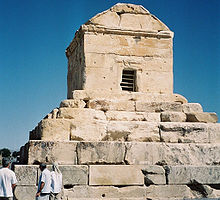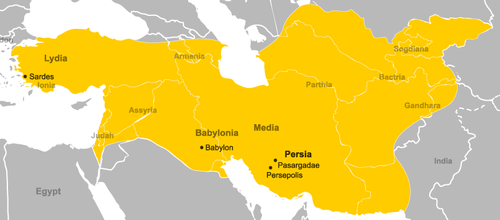|
 Cyrus the Great , also known as Cyrus II or Cyrus of Persia, He was the founder of the Persian Empire under the Achaemenid dynasty. Cyrus the Great , also known as Cyrus II or Cyrus of Persia, He was the founder of the Persian Empire under the Achaemenid dynasty.
It was under his own rule that the empire embraced all previous civilized states of the ancient Near East,[8] expanded vastly and eventually conquered most of Southwest Asia and much of Central Asia, parts of Europe and Caucasus. From Mediterranean sea and the Hellespont in the west to the Indus River in the east, to create the largest empire the world had yet seen.
The reign of Cyrus lasted 29 to 31 years. Cyrus built his empire by fighting and conquering first the Median Empire, then the Lydian Empire and the Neo-Babylonian Empire. Either before or after Babylon, he led an expedition into central Asia, which resulted in major campaigns that brought "into subjection every nation without exception." Cyrus did not venture into Egypt, as he himself died in battle, fighting the Massagetae along the Syr Darya in December 530 BC. He was succeeded by his son, Cambyses II, who managed to add to the empire by conquering Egypt, Nubia, and Cyrenaica during his short rule.
As a military leader, Cyrus left a legacy on the art of leadership and decision making, and he attributed his success to "Diversity in counsel, unity in command." Cyrus the Great respected the customs and religions of the lands he conquered. It is said that in universal history, the role of the Achaemenid empire founded by Cyrus lies in its very successful model for centralized administration and establishing a government working to the advantage and profit of its subjects. In fact, the administration of the empire through satraps and the vital principle of forming a government at Pasargadae were the work of Cyrus. Aside from his own nation, Iran, Cyrus also left a lasting legacy on Jewish religion (through his Edict of Restoration), human rights, politics, and military strategy, as well as on both Eastern and Western civilizations.

Etymology
Main article: Etymology of Cyrus
The word Cyrus is derived, via Latin, from Ancient Greek, from Old Persian likely originally from Elamite Kurash meaning to bestow care.
The name has been recorded in ancient inscriptions in many different languages. The ancient Greek historians Ctesias and Plutarch noted that Cyrus was named from Kuros, the Sun, a concept which has been interpreted as meaning "like the Sun" by noting its relation to the Persian noun for sun, khor, while using -vash as a suffix of likeness. However, Karl Hoffmann and Rüdiger Schmitt of the Encyclopædia Iranica have suggested the translation "humiliator of the enemy in verbal contest."
In Iran, Cyrus is always referred to as "Kūrošé Bozorg" and/or "Kūrošé Kabīr" — meaning "Cyrus the Great". In the Bible, he is known as simply Koresh (Hebrew: כורש).
The Persian domination and kingdom in the Iranian plateau started by an extension of the Achaemenid dynasty, who expanded their earlier domination possibly from the 9th century BC onward. The eponymous founder of this dynasty was Achaemenes (from Old Persian Haxāmaniš). Achaemenids are "descendants of Achaemenes" as Darius the Great, the ninth king of the dynasty, traces his genealogy to him and declares "for this reason we are called Achaemenids". Achaemenes built the state Parsumash in the southwest of Iran and was succeeded by Teispes, who took the title "King of Anshan" after seizing Anshan city and enlarging his kingdom further to include Pars proper. Ancient documents mention that Teispes had a son called Cyrus I, who also succeeded his father as "king of Anshan". Cyrus I had a full brother whose name is recorded as Ariaramnes.
In 600 BC, Cyrus I was succeeded by his son Cambyses I who reigned until 559 BC. Cyrus the Great was a son of Cambyses I, who named his son after his father, Cyrus I. There are several inscriptions of Cyrus the Great and later kings that refer to Cambyses I as "great king" and "king of Anshan". Among these are some passages in the Cyrus cylinder where Cyrus calls himself "son of Cambyses, great king, king of Anshan". Another inscription (from CM's) mentions Cambyses I as "mighty king" and "an Achaemenian", which according to bulk of scholarly opinion was engraved under Darius and considered as a later forgery by Darius . However "Cambyses II"'s maternal grandfather Pharnaspes is named by Herodotus as "an Achaemenian" too. Xenophon's account in Cyropædia further names Cambyses's wife as Mandane and mentions Cambyses as king of Persia. These agree with Cyrus's own inscriptions, as Anshan and Parsa were different names of the same land. These also agree with other non-Iranian accounts, except at one point from Herodotus that Cambyses was not a king but a "Persian of good family". However, in some other passages, his account is wrong also on the name of the son of Chishpish, which he mentions as Cambyses but, according to modern scholars, should be Cyrus I.
The traditional view which based on archaeological research and the genealogy given in the Behistun Inscription and Herodotus held that Cyrus was an Achaemenian. However it has been suggested by M. Waters and that Cyrus is unrelated to Achaemenes or Darius the Great and that his family was of Teispid and Anshanite origin instead of Achaemenid, though this view is not universally accepted.[citation needed]
[edit] Early life
The best-known date for the birth of Cyrus is either 600-599 BC or 576-575 BC. Little is known of his early years, as there are only a few sources known to detail that part of his life, and they have been damaged or lost.
Herodotus' story of Cyrus's early life belongs to a genre of legends in which abandoned children of noble birth, such as Oedipus and Romulus and Remus, return to claim their royal positions. Similar to other culture heroes and founders of great empires, folk traditions abound regarding his family background. According to Herodotus, he was the grandson of the Median king Astyages and was brought up by humble herding folk. In another version, he was presented as the son of poor parents who worked in the Median court. These folk stories are, however, contradicted by his own testimony, according to which he was preceded as king of Persia by his father, grandfather and great-grandfather.
After the birth of Cyrus, Astyages had a dream that his Magi interpreted as a sign that his grandson would eventually overthrow him. He then ordered his steward Harpagus to kill the infant. Harpagus, morally unable to kill a newborn, summoned the Mardian Mitradates (which the historian Nicolaus of Damascus calls Atradates), a royal bandit herdsman from the mountainous region bordering the Saspires, and ordered him to leave the baby to die in the mountains. Luckily, the herdsman and his wife (whom Herodotus calls Cyno in Greek, and Spaca-o in Median) took pity and raised the child as their own, passing off their recently stillbirth infant as the murdered Cyrus. For the origin of Cyrus's mother, Herodotus says Mandane of Media and Ctesias insist that she is full Persian but give no name, while Nicolaus gives the name Argoste as Atradates' wife, whether this figure represents Cyno or Cambyses' unnamed Persian queen has yet to be determined. It is also known that Strabo says that Cyrus was originally named Agradates by his stepparents; therefore, it is probable that, when reuniting with his original family, in custom Cambyses names him (or had named him before the separation) Cyrus after his own father, who was Cyrus I.
Herodotus claims that when Cyrus was ten years old, it was obvious that Cyrus was not a herdsman's son, stating that his behavior was too noble. Astyages interviewed the boy and noticed that they resembled each other. Astyages ordered Harpagus to explain what he had done with the baby, and, after confessing that he had not killed the boy, the king tricked him into eating his own broiled and chopped up son. Astyages was more lenient with Cyrus and allowed him to return to his biological parents, Cambyses and Mandane. While Herodotus's description may be a legend, it does give insight into the figures surrounding Cyrus the Great's early life.
Cyrus had a wife named Cassandane. She was an Achaemenian and daughter of Pharnaspes. From this marriage, Cyrus had four children: Cambyses II, Bardiya, Atossa, and another daughter whose name is not attested in ancient sources. Also, Cyrus had a fifth child named Artystone, the sister or half-sister of Atossa, who may not have been the daughter of Cassandane. Cyrus had a special dearly love for Cassandane, and, according to the chronicle of Nabonidus, when she died, all the nations of Cyrus's empire observed "a great mourning", and, particularly in Babylonia, there was probably even a public mourning lasting for six days (identified from 21–26 March 538 BC). Her tomb is suggested to be at Cyrus's capital, Pasargadae. There are other accounts suggesting that Cyrus the Great also married a daughter of the Median king Astyages, named Amytis. This name may not be the correct one, however. Cyrus probably had once and after the death of Cassandane a Median woman in his royal family. Cyrus' sons Cambyses II and Smerdis both later became kings of Persia, respectively, and his daughter Atossa married Darius the Great and bore him Xerxes I.
 |